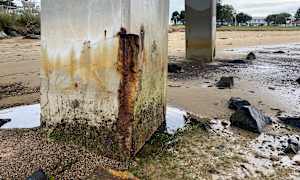TEYS Australia, the nation's second-largest meat processor and exporter, wasn’t even there.
O'Connors of Pakenham were there but not operating.
And a throwaway line from one of their representatives explained, at least in part, why prices were $600, $800 or even $1000 lower for store cattle at Leongatha on Friday, March 24 than they had been this time last year.
“The feedlots are chockers,” he said.
Where last year, feedlots up and down the eastern seaboard of Australia, and in South Australia, were desperate for young cattle to fatten and export to fill orders, that’s not the case now.
Previously parched properties in Queensland and NSW have well and truly restocked, and after a couple of good years, they are finally turning off well-advanced young cattle in their droves.
Where this small pocket of South Gippsland has continually survived the worst ravages of drought, to keep on churning out well-bred, forward young cattle and finished bullocks, to be the saving grace of the beef industry, the forces of supply and demand are back in town, with a vengeance.
And local producers selling their annual drafts of autumn store cattle, after the season has turned dry and ahead of the winter, had to take what they could get.
But it was no surprise to see prices continuing to settle back after what happened at the annual high country sales last week, which witnessed drops of $800 to $1000-a-head, across the five sales at Hinnomunjie, Omeo, Benambra and Ensay from the “crazy prices” of last year.
Those dizzy heights are a distant memory now.
A pen of 21 crossbred dairy steers from Maffra, weighing an average of 378kg, which might have made up to $1400-a-head last year, struggled to attract a bid even under the expert urging of Brian McCormack of Nutrien Ag.
Hopefully calling for bids above $700, he got a start at $500 and painstakingly moved the offers forward to a knockdown price of $590. It was hard work.
* A pen of 11 Angus steers (Mardan Lodge) that might have sold for as much as $3000 12 months ago, and $2300 in 2021, sold for an average of $1700.
* A run of 72 vendor-bred Angus steers (Harris Farms partnership Dumbalk), sold for an average of $1600 where they might have sold for $1900 in 2021 and $600-$800 more 12 months ago.
* A run of bigger Angus steers averaging 563kg (N Belcher Woodside), sold for $2200 and $2300-a-head.
* 13 x Speckle Park steers (L Henderson Newry) averaging $484kg sold for $1100.
“It’s been a good season at Woodside, the rainfall was average but we got it at the right time so the stock are looking good but it’s March, so it’s gone off yes and the cattle have to go,” said Peter Boddy.
“Of course, it’s disappointing,” he said, of a price that’s come back as much as $800-a-head from last year.
“But that’s the way it is. We can’t keep them. We keep trading.”
And with 600 breeders to look after it’s on with the job.
Shane Harris, representing the Harris Farms family partnership was equally philosophical.
His 72 vendor-bred Angus steers sold for an average of $1600-a-head, also well down on last year .
“Under the circumstances, we’re happy with that. You have to be. That’s the way it is,” said Shane.
“We don’t always put cattle in here, usually selling them direct, but they’re gone now.”
Nutrien Ag Leongatha director Terry Ginnane acknowledged the fall in prices but said the industry remained buoyant.
“Most people in agriculture have seen it happen before. We’ve come off the best year we’ve ever seen. The prices had got to a really high level, now they’ve come right back.
“It’s like the share market, you might make a loss when you sell but there’s still a margin in it and you move on.”
Reflecting the high returns of recent years, farm values remain high, according to Mr Ginnane, but the volume of sales, at those heady prices, has slowed right down.














